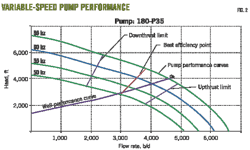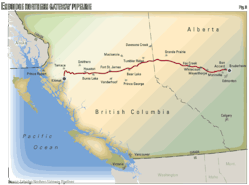David Pavel, Brian Grayson
Weatherford International Ltd.
Houston
Adding automation to a closed-loop circulating system improves information and management capabilities that contribute to greater safety and efficiency in drilling operations.
This third part of a four-part series of articles describes the type of automation available for closed-loop systems. The two previous articles (OGJ, Dec. 6, 2010, p. 84, and Jan. 3, 2011, p. 86) covered the system fundamentals and manual pressure management.
The concluding part (OGJ, Mar. 7, 2011) will examine how closed-loop pressure data help optimize a well plan and enhance a well completion.
Managing wellbore pressure in a closed-loop system affords advantages in safety and efficiency vs. traditional mud return systems that are open to the atmosphere. Based on real-time flow and pressure data, manual manipulation of annular backpressure provides an almost instantaneous capability to manage very small wellbore influxes and losses before they can develop into a well control event, as discussed in Part 2.
But manual manipulation still has the human element to contend with. Thus the next step in wellbore pressure management is automation in which the managed pressure drilling (MPD) system itself, through its own internal algorithms, identifies what is occurring downhole and reacts automatically.
In this mode, the MPD control apparatus functions effectively as a supervisory control and data acquisition (SCADA) system.
A key element of this automation is a control-loop feedback mechanism commonly used in industrial control systems that consists of a proportional-integral-derivative controller, tailored to characterize the MPD equipment (choke actuators) and capable of adaptation to changing dynamics such as mud systems, well compressibility or lack thereof, drilling windows, and surface equipment limitations (Fig. 1).
Its installation on the well site provides a new level of oversight, yielding additional safety and efficiency in drilling applications and a change in the economics of deepwater development.
As discussed in previous parts, Weatherford's closed-loop system (Microflux) has operated successfully on more than 80 wells worldwide since 2006. It has been installed on land, jack up, platform, and floating rigs to drill exploratory and development wells, and the system affords operational and economic benefits for drilling ultradeepwater wells.
Scalable pressure management
The pressure management system used to implement SCADA standards is a flexible, scalable technology based on a closed-loop drilling system. This control system integrates several key components that are common rig equipment (Fig. 2).
Weatherford's automated MPD system has four main components: a rotating control device, mass flowmeter, drilling chokes, and intelligent control unit (Fig. 2).
A rotating control device (RCD) atop the BOP is a standard tool for containing and safely diverting annular drilling returns. It also completes the circulating system to create a closed loop of incompressible drilling fluid. In this contained environment, minute wellbore influxes or losses are immediately detectable at the surface. Analysis of these pressure and flow data by the control system provides a highly responsive capability for early kick and loss detection in both conventional drilling and MPD operations.
In a similar fashion, introducing pressure changes to this incompressible circuit of fluid at the surface causes quick changes to the annular pressure profile. The use of a choke manifold or an auxiliary fluid pump to apply surface pressure within the closed loop results in an almost immediate and reciprocal change in bottomhole pressure.
A configuration using just the RCD and analysis capabilities is the most basic application of the control technology. The move to MPD operations, either manual or automatic, comes with the decision to begin actively managing wellbore pressure using surface backpressure.
Managing the loop
The change from manual MPD to automated MPD is a matter of enhanced precision and timely counteraction to address unplanned events. Manual MPD operations involve reading data and interpreting it and then reacting manually. In the automated mode, the system uses its own internal algorithms to identify what is occurring in the wellbore and apply an automatic response.
When operated manually, MPD systems require coordination between individuals, including the driller, a choke operator, data-acquisition personnel, and a data-interpretation specialist. Incoming data first require attention and recognition that something is occurring before an action is taken. That requires time.
In the tight pore pressure and fracture gradient windows typical in deepwater wells, a key to success often involves the maintaining of a predefined pressure at a specific depth in the well. This involves eliminating and minimizing the pressure spikes and oscillations, respectively, that might exceed the drilling window parameters and create a kick-loss scenario.
These circumstances commonly involve pressure regimes that are less than 100 psi between the respective gradients. In manual operations, it is hard to keep those peaks and valleys within a 100-psi window. For instance, in a common method, the procedure calls for applying backpressure manually when the pumps are turned off. Time is limited and even a brief delay in coordination between the MPD engineer and the driller is problematic.
Hydraulics modeling can characterize the application of surface pressure to overcome rheological phenomenon, such as the gelling effect of certain oil-based fluids or temperature effects of high pressure and high-temperature wells.
While manual MPD methods regularly operate safely and effectively in tight windows, some applications exceed even those operational capabilities. In these circumstances, the speed and accuracy of an automated system facilitates optimal pressure management to enhance safety and performance and offers an advantage over the drilling team manually attempting to balance system oscillations.
Wellbore industrial automation
A core technology in the automating MPD process is a proportional-integral-derivative controller system. A PID system is a common component of industrial automation, aviation, and other processes. In MPD operations, a PID provides the feedback used to finely adjust and stabilize wellbore pressure.
This is analogous to flying a high-performance aircraft. To achieve exceptional flight characteristics, a feedback loop processes a pilot's maneuvers and controls all the flight surfaces to provide the optimum equilibrium.
In an MPD system, a similar approach stabilizes wellbore pressure fluctuations by managing pressure quickly in small increments. These increments can be as small as ±1 psi when circulating homogeneous fluid or during pipe connections with the aid of auxiliary flow, or as much as ±10 psi when circulating gas or large cuttings.
In other cases such as when tripping in or out with as much as 500 psi of surface pressure, observed increments or decrements in pressure can range from 5 to 20 psi.
This finesse is critical when responding to rapid variations in well pressure or in manipulating the bottomhole pressure when pumping stops during a connection. With an automated system, the fine-tuning adjustments are instantaneous and in a more orchestrated manner than manual adjustments.
Automation also enables annular pressure management that maintains a predefined pressure in the wellbore. This pressure consistency can be problematic when coordinating the speed at which the driller turns off the pumps and the response of the MPD operator's adjustments in the backpressure pump and choke.
When the driller turns off the pumps too quickly, this action causes spikes and valleys in downhole pressure. The MPD operators then have a more difficult task of building and holding backpressure while trying to minimize the pressure fluctuations.
With annular pressure control, if the flow coming out of the well decreases rapidly, the system automatically adjusts backpressure to hold the operator-defined set points. This is also applicable to overcoming pump problems when drilling ahead such as in the case of pop-off occurrences and stalled motors.
Supervised automation
While the automated system drives itself, the MPD operations nevertheless require on site monitoring and input. Oversight is critical because of uncertainties that come with drilling a well. If the process could be precisely described in advance, as in a factory, it could be programmed into the system.
But the drilling is not a steady-state process. While drilling ahead, the bit can encounter unexpected fractures or abnormally pressured zones. How much a zone will produce before it depletes or how much fluid a fracture might take often is unknown. While a system may have various set points defined based on what is anticipated, these may not be the right set points for the actual conditions.
In the case of an automated control system, a person has to make that assessment and change the set points. The system is automated per its reaction but is not drilling the well on its own. The process requires expert support for a guided automation.
To return to the airplane analogy, once on autopilot the plane cruises at a set altitude and speed, and all is fine until it hits turbulence. The autopilot does not know what to change to escape the turbulence. The pilot has to make the course correction and change altitude.
Revising the flight plan is effectively what the MPD operator does with an automated system.
Preplanning
MPD automation is not an artificial-intelligence system. But because of the way ballooning looks vs. taking a loss, the system can characterize the event. All the measured parameters contribute to that picture and each data set contributes to real-time trending information.
All this depends on how the MPD operator sets up the system. The initial human interface includes establishing the pressure and flow differential dead-bands and time duration desired before the system reacts.
Setting these limits incorrectly can pose problems. For example, specifying a 1-sec trend time and small differentials in flow and pressure would trigger frequent automatic responses acting upon normal fluctuations in mass balance such as those caused by heaving or pipe movement. This would make the identification of events less reliable.
The planning support for putting in limits involves using a predesignated time filter to examine data in, for instance, 5-10 sec increments, at various pressure and flow conditions. The system as programmed would not react unless it sees something over this specific time period.
This trending needs to be done for both very short and longer periods.
Overcoming obstacles
Fine-tuned pressure detection and management provides safety and efficiency advantages in some of the world's most extreme conditions. For instance in Pakistan, Weatherford's system played a critical role in drilling where conventional systems were unable to operate.
The high-pressure, high-temperature Kirthar fold belt presents numerous challenges, including a very narrow pore pressure and fracture gradient window of only 0.4 kg/sq cm equivalent mud weight.
The drilling operation involved circulating out up to 50% gas cut mud and preventing kicks, lost circulation, and differential sticking. The system proved capable of detecting and controlling an influx of less than 1.5 bbl within 2 min (Fig. 3).
This screen display shows an influx being circulated out of the well during the drilling of the 81⁄2-in section. The increase in the outward flow rate (red) shows the influx. The annular backpressure has been increased to compensate, as has the standpipe pressure. The system allowed drilling to continue while handling up to a 50% gas cut fluid in the annular flow (Fig. 3).
MPD methods coupled with the operator's proprietary continuous circulating valves made it possible to drill the well successfully, which consisted of a target formation of hydrocarbon-rich sandstone and a mixture of limestone and interbedded shale
The weak and vuggy limestone presented difficult and costly mud losses and pockets of high-pressure gas challenge safety and efficiency. A gas slug that occurred in an earlier, conventionally drilled well resulted in 6 days of nonproductive time.
Pressure data
The system also provides the emerging capability to predict pressure ahead of the bit for optimizing completions.
The measurements near the bit allow real-time calibration of pressure predictions for optimizing drilling and well planning on the fly. Integrated with data from other instruments, such as specialized mug logging gas chromatographs for characterizing hydrocarbons, further extend the system's capabilities.
By capturing reservoir information, closed-loop systems help in determining geophysical insights for optimizing completions.
More Oil & Gas Journal Current Issue Articles
More Oil & Gas Journal Archives Issue Articles
View Oil and Gas Articles on PennEnergy.com



